Our Publications
Recent Publications
List 1: publications concerning selected topics. Entered in the order of publication dates, most recent publications added below.
List 2: Publications in alphabetic order of authors, Conservation Biology Unit, Ruhr-University Bochum (to be deleted soon)
| Publications about species & selected topics |
by philincon & coworkers
→ Biodiversity research, ecology, ornithology and conservation
→ Seed dispersal: importance for regeneration of rain forest
→ Hornbill research and conservation
→ The newly discovered Panay monitor or mabitang
→ Publication list of M. Gaulke: studies of Philippine reptile and amphibian fauna in connection with PanayCon / former PESCP

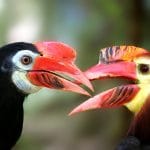
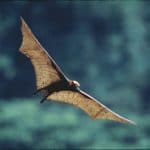

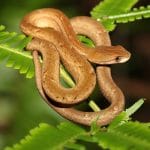
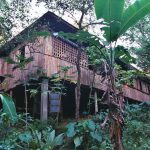
Biodiversity research, ecology, ornithology & Conservation
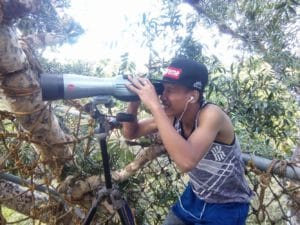
Göth, A. & U. Vogel (1995): Status of the Polynesian Megapode, Megapodius pritchardii, on Niuafo’ou. Bird Cons. Intl. 5, 117-118 [DOI]
Curio, E. & H. Onnebrink (1995): Brood defense and brood size in the great tit (Parus major): a test of a model of unshared parental investment. Behav. Ecol. 6, 115-142
Curio E. (1996): Conservation needs ethology. Trends Ecol. Evol. 11, 260-263
Curio, E. (2017): Avian resource defense against an insect competitor and a cognition problem. Ökol. Vögel (Ecol Birds) (in press)
Cordts, R. & L. Partridge (1996): Courtship reduces longevity of male Drosophila melanogaster. Anim. Behav. 52, 269-278 [DOI]
Göth, A. & U. Vogel (1996): Egg laying and incubation of the Polynesian Megapode. Ann. Rev. WPA, pp. 43-54
Witte, K. (1996): The differential allocation hypothesis: does the evidence support it? Evolution 49, 1289-1290
Cordts, R. (1997): Fortpflanzungswert, reproduktiver Aufwand und Juvenilhormon beim Heimchen (Acheta domesticus L.). Dissertation Ruhr-Universität Bochum (German). (Reproductive value, reproductive effort and juvenile hormone in the Domestic Cricket (Acheta domesticus L.)
de Soye, Y. (1997): Conservation research on Panay: key facts of preliminary surveys. Abstract. In: Symposium-Workshop, ´Protected Areas: National Strategy for Biological Diversity Conservation´, 1997, Inst. Forest Conservation, University of the Philippines, Los Baños, Laguna
Curio, E (1998): Behavior as a Tool for Management Intervention in Birds. In: Caro (ed.). Behavioral Ecology and Conservation Biology, Oxford Univ. Press, 163-187
Klop, E., E. Curio & Y. de Soye (1998): A new population of bleeding-heart pigeon (Gallicolumba sp.) and its conservation relevance on Panay, Philippines. J. Ornithol. 139, 76-77 [DOI]
Göth, A. & U. Vogel (1999): Notes on breeding and conservation of birds on Niuafo’ou Island, Kingdom of Tonga. Pacific Conservation Biology 5, 103-114
Göth, A., U. Vogel & E. Curio (1999): The acoustic communication of the Polynesian Megapode Megapodius pritchardii G. R. Gray. Proc.Third Intl. Megapode Sympos., Zool. Verh. Leiden 327, 37-51
Hamann, A., E. B. Barbon, E. Curio & D. A. Madulid (1999): A forest inventory of a submontane tropical rainforest on Negros Island, Philippines. Biodiversity and Cons. 8, 1017-1031 [DOI]
Klappert, K. & E. Curio (1999): Cuckoldry in great tits: the role of fluctuating asymmetry and parasite infestation in male birds. Zoology 2, Suppl. II, p.29 (DZG Proc. 92nd Ann. Meeting Innsbruck)
Witte, K., U. Hirschler & E. Curio (2000): Sexual imprinting oni a novel adornment influences mate preferences in ithe Javanese Mannikin Lonchura leucogastroides. Ethology 106, 349-363 [DOI]
Plenge, M., E. Curio & K. Witte (2000): Sexual imprinting supports the evolution of novel male traits by transference of a preference for the colour red. Behaviour 137, 741-758 [DOI]
Curio, E., S. Luft & J. Reiter (2000): Die Dolchstichtaube von Panay, Philippinen – eine erste Bilddokumentation. Nachr. Vereinigg. f. Artenschutz, Vogelhaltung, Vogelzucht 47, 386-389 (German)
Curio, E., J. Hornbuckle, Y. de Soye, P. Aston & L. L. Lastimoza (2001): New birds records for the island of Panay, Philippines, including the first record of the Asian Stubtail Urosphaena squameiceps for the Philippines. Bull. B.O.C. 121, 183-197
Curio, E. (2001): Wie Vögel ihr Auge schützen: Zur Arbeitsteilung von Oberlid, Unterlid und Nickhaut. J. Ornithol. 42, 257-272. (German). (On how birds protect their eyes: The division of labour of the upper lid, lower lid and the nictitating membrane) [DOI]
Curio, E. (2002): Prioritisation of Philippine island avifaunas for conservation: A new combinatorial measure. Biol. Conserv. 106, 373-380 [DOI]
Curio, E. (2002): Die Qual der Wahl. ZGF Nachrichten 2, 18-19 (German)
Hamann, A. (2002): The North Negros Forest Reserve: A biodiversity hotspot at risk. Silliman Journal 43: 83-90
Curio, E. (2008) Gehen oder bleiben? Der kluge Naturschützer und der Concorde-Fehler. ZGF Gorilla, 3/2008, 18-19. [Stay or leave? The clever conservationist and the Concorde Fallacy]. ZGF Gorilla 3: 18-19. (German)
Freudenschuss, M., A. Grabrolle & H. Krehenwinkel (2016): A new species of Gambaquezonia from the Philippine Island of Panay (Araneae: Salticidae). Arachnology 17: 25-27.
Curio, E. (2014): Avian resource defence against an insect competitor and a cognition problem. Ökol. Vögel (Ecol Birds) 35: 117-126.
Schmidt-Raesa, A. & C. J. Schwarz (2016): Nematomorpha from the Philippines, with description of two new species. Zootaxa 4158 (2): 246-260. [DOI]
Schwarz, C. J. (2017): Update on Tagalomantis manillensis (Saussure), with description of the female and comments on its systematic placement and life history (Insecta: Mantodea: Deroplatyinae). Stuttgarter Beiträge zur Naturkunde A, 10. Jg.:19-39. [DOI]
Mynott, H. I. et al. (2021): Population assessment and habitat associations of the Visayan Hornbill (Penelopides panini) in Northwest Panay, Philippines. Avian Res 12, 67 (2021). [DOI] https://avianres.biomedcentral.com/articles/10.1186/s40657-021-00303-3
Seed Dispersal: importance for regeneration of rainforest
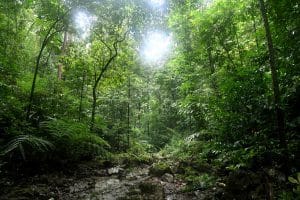
Curio, E. (1998): Forschungen zur Erhaltung fruchtfressender Vögel und ihrer Wälder auf den Philippinen. J. Ornithol. 139, 91 (German)
Hamann, A. & E. Curio (1999): The role of frugivores in the regeneration of a Philippine montane rainforest. Cons. Biol. 13, 766-773
Heindl, M. & E. Curio (1999): Observations of frugivorous birds at fruit-bearing plants in the North Negros Forest Reserve, Philippines. Ecotropica 5, 157-181
Luft, S. (2000): The use of olfactory cues in food location by Philippine fruit bats (Megachiroptera: Pteropodidae). Myotis 38, 109-112
Curio, E. (2000): Tier-Pflanze-Beziehungen: Frugivorie philippinischer Vögel. Orn. Anz. 39, 81-85 (German)
Schabacker, J. & E. Curio (2000): Fruit characteristics as determinants of gut passage in a bulbul (Hypsipetes philippinus). Ecotropica 6, 157-168
Heindl, M. & E. Curio (2001): Duration of visits to fig trees of foraging avian frugivores in the Philippines. Ecology of Birds 23, 241-255
Curio, E. (2002): Die Qual der Wahl. Mitt. (Newsletter) Zool. Ges. Frankfurt, 2002/2, 18-19 (German)
Curio, E., S. Luft & J. Reiter (2002): Vegetarische ‘Vampire’ – Flughunde als Gärtner im Regenwald. Rubin 12, 56-61. English version also available: Vegetarian ‘vampires’ – fruit bats gardening the rain forest. Ibidem
Luft, S. , B. Tacud, H. Urbina & F. Geronimo (2002): Visual fruit preferences of Visayan Tarictic Hornbills, Penelopides panini panini (Bucerotiformes: Bucerotidae), and Musky Fruit Bats, Ptenochirus jagori (Megachiroptera: Pteropodidae), in cafeteria experiments. Silliman Journal 43: 42-58
Reiter, J. (2002): Differential ingestion of Ficus seeds by frugivorous bats: a first experimental test in Ptenochirus jagori (Pteropodidae). Acta Chiropterologica 4, 99-106 [DOI]
Schabacker, J. & E. Curio (2002): Notes on fruit consumption of the Philippine Bulbul (Hypsipetes philippinus) and its quality as a seed disperser. Silliman Journal 43, 59-82 (2002)
Luft, S., E. Curio & B. Tacud (2003): The use of olfaction in the foraging behaviour of the Golden-mantled Flying Fox, Pteropus pumilus, and the Greater Musky Fruit Bat, Ptenochirus jagori (Megachiroptera: Pteropodidae). Naturwissenschaften 90 (2), 84-87 [DOI]
Curio, E., J. Reiter, B. Tacud, H. Urbina & C. Fink-Schabacker (2003): Seedling mortality of six Philippine rain forest tree species: a test of the ‘Escape Hypothesis’. Ecotropica 9, 59-70. Content: the first test in the Old World of Janzen´s idea that seedling survival increases with increasing distance from parent tree. This highlights the importance of seed dispersal by, e.g., hornbills.
Reiter, J., E. Curio, B. Tacud, H. Urbina & F. Geronimo (2004): Enhanced seed germination in Ficus and non-Ficus species after ingestion by Ptenochirus jagori (Pteropodidae). Myotis 41-42: 81-91.
Reiter, J., E. Curio, B. Tacud, H. Urbina & F. Geronimo (2006): Tracking bat-dispersed seeds using fluorescent pigment. Biotropica 38 (1): 64-68.
Hornbill Research & conservation

Curio, E. (1995): Philippine Hornbills. EEP Hornbill TAG Newsletter 1, 11
Curio, E. (1995): Philippine Hornbill Research and Captive Breeding Project. EEP Hornbill TAG Newsletter 1, 12
Curio, E., A. Hamann & L.L. Lastimoza (1996): The appearance and status of the Wrinkled Hornbill (Aceros waldeni) on Panay. OBC Bull. 23, 18-20
Curio, E., A. Hamann, P. Heubüschl & L.L. Lastimoza (1996): Hornbill research and conservation in the Philippines. EEP Hornbill TAG Newsletter 2, 26-27
Curio, E. (1997): Schutz und Erforschung der bedrohtesten Nashornvögel der Philippinen. Mitt. Zool. Ges. Frankfurt 1: 12-14
Curio, E. (1998): The first ‘soft release’ of a juvenile Tarictic Hornbill (Penelopides panini panini). Publication No. 19 of the Philippine Endemic Species Conservation Project (PESCP) of the Frankfurt Zoological Society. Report compiled from records of Fel C. Cadiz, Benjamin ‘June’ Tacud, Henry Urbina and Eberhard Curio.
Kauth, M., S. Engel, L.L. Lastimoza & E. Curio (1998): Observations on the breeding biology of the Writhed-billed Hornbill (Aceros waldeni) in the Philippines. J. Ornithol. 139: 475-483 [DOI]
Klop, E.:, M. Kauth, T. Hahn, S. Engel, L.L. Lastimoza & E. Curio (1999): Diet composition and food provisioning of the Visayan Tarictic Hornbill ( Penelopides panini panini) during the breeding season. Ecol. Birds 21, 389-404
Curio, E. (1999): Bau von Auffangvolieren zur Aufzucht und zur Vorbereitung der Auswilderung kritisch bedrohter Hornvögel der Philippinen. Nachr. Vereinigg. f. Artenschutz, Vogelhaltung, Vogelzucht 46, 1006-1007 (German)
Klop, E., E. Curio & L.L. Lastimoza (2000): Breeding biology, nest site characteristics and nest spacing of the Visayan Tarictic Hornbill (Penelopides panini panini) on Panay, Philippines. Bird Cons. Intl. 10, 17-27 [DOI]
Luft, S. (2000): Letzte Chance für die Hornvögel auf der Philippinen-Insel Panay! Gef. Welt , 124, 382-385
Luft, S. , B. Tacud, H. Urbina & F. Geronimo (2002): Visual fruit preferences of Visayan Tarictic Hornbills, Penelopides panini panini (Bucerotiformes: Bucerotidae), and Musky Fruit Bats, Ptenochirus jagori (Megachiroptera: Pteropodidae), in cafeteria experiments. Silliman Journal 43: 42-58
Curio, E. (submitted): The First ‚Soft Release’ of a Juvenile Tarictic Hornbill (Penelopides panini panini)
Lastimoza, L.L., E. Curio & G. Meier (in press): Philippine Hornbill Research Update. World Hornbill News
Klop, E. (in press): The breeding biology of the Visayan Tarictic Hornbill (Penelopides panini panini). World Hornbill News
Demegillo, A., F. C. Cadiz, R. Lestino, A. Alabado, J. Venus & E. Curio (2003): Hornbill nest protection project in northwest Panay. Abstr., 12th Philippine Biodiversity Sympos. WCSP, Mambukal Resort (2003)
Slade, E., J. Villanueva & E. Curio (2003): The first releases of the Visayan Tarictic Hornbill (Penelopides panini panini) in the Northwest Panay peninsula. Abstr., 12 Philippine Biodiversity Sympos. WCSP, Mambukal Resort (2003)
Temur, F., Künzel, T. & E. Curio (2003): Conservation measures to intervene against hunting Writhed-billed Hornbills (Aceros waldeni) in the Central Panay Mountain Range. Mid year report, executed by Philippine Endemic Species Conservation Project in cooperation with Frankfurt Zoological Society, funded by ‘GEO Protects the Rainforest’, Germany. Unpublished Report, Ruhr-Universität Bochum.
Lichtblicke für die Natur (2003): Newsletter, Stiftung bedrohte Tierwelt (Foundation for Endangered Wildlife). Frankfurt Zoological Society (German, authored by E. Curio: Highlights of Progress for Nature).
Curio, E. (2004): On ornamental maturation of two Philippine hornbill species with a note on physiological colour change. J. Ornithol. 145, 227-237. [DOI]
Curio, E. (2005): Notes on two species of endangered Philippine hornbills with an emphasis on breeding biology. Pp. 11-24 in: Lum, S. & P. Poonswad (eds.): The ecology of hornbills: reproduction and populations. Proc. 3rd International Hornbill Workshop. Bangkok: Pimdee Karnpim Co., Ltd., 248 pp.
Hembra, S. S., B. Tacud, E. Geronimo, J. Villanueva, J. Jamangal, E. Sanchez, N. Bagac & E. Curio (2006): Saving Philippine Hornbills on Panay Island. Re-introduction News, No. 25: 45-46
Alabado A, Lestino R, Venus J, Elio R, Kuenzel T & Curio E (2007). PESCP’s protection program for the last substantial sized population of the Dulungan hornbill. In: Thirteenth Annual Report of PESCP (ed. E. Curio), Pandan, Antique, Philippines, pp. 47 – 49.
Alabado A, Lestino R, Venus J, Ibabao M, Kuenzel T & Curio E (2009): 1.4 PESCP’s Protection Program from 2002 to 2008 for the last substantial sized Population of the Dulungan Hornbill (Aceros waldeni) – Final Report for 2008. Pp. 39 – 40 in: PESCP Fifteenth Annual Report, 2009. Availability as a download see our homepage.
Sammler, S. & R. Tiedemann (2009): Struktur des mitochondrialen Genoms zweier philippinischer Hornvogelarten. Vogelwarte 47: 336-337.
Ann. Meeting Deutsche Ornithologen-Gesellschaft 2009, Abstract (German)
Curio, E. (2010): Projektbilanz: Erfahrungen mit der Aufzucht und Auswilderung von Hornvögeln auf Panay, Philippinen. Zum Fliegen geboren – Flying Free, Neue Folge 28: 3-5. (German)
Sammler, S., Bleidorn, Ch. & R. Tiedemann (2011): Struktur des mitochondrialen Genoms zweier philippinischer Hornvogelarten. BMC Genomics 2011, 12: 35
doi:10.1186/1471-2164-12-35
Sammler, S., Bleidorn, C. & Tiedemann, R. (2011a): Full mitochondrial genome sequences of two endemic Philippine hornbill species (Aves: Bucerotidae) provide evidence for pervasive mitochondrial DNA recombination. BMC Genomics 12: doi:10.1186/1471-2164-12-35. [DOI]
Sammler, S., K. Havenstein & R. Tiedemann (2011): Fourteen new microsatellite markers for the Visayan tarictic hornbill (Penelopides panini) and their cross-species applicability among other endangered Philippine hornbills. Conservation Genetics Resources 4 (2): 435-438.
DOI 10.1007/s12686-011-9567-4. [DOI]
Sammler, S., Ketmaier, V., Havenstein, K., Krause, U., Curio, E. & Tiedemann, R. (2012): Mitochondrial control region I and microsatellite analyses of endangered Philippine hornbill species (Aves; Bucerotidae) detect gene flow between island populations and genetic diversity loss. BMC Evolutionary Biology 12: 203
doi:10.1186/1471-2148-12-203. [DOI]
Sammler, S., Ketmaier, V., Havenstein, K. & Tiedemann, R. (2013): Intraspecific Rearrangement of Duplicated Mitochondrial Control Regions in the Luzon Tarictic Hornbill Penelopides manillae (Aves: Bucerotidae). J. Mol. Evol. 77: 199-205. [DOI]
Schwarz, Christian & Curio, Eberhard. Poster. (2019): PhilinCon’s nest guarding program for the Critically Endangered Walden’s Hornbill or Dulungan (Rhabdotorrhinus waldeni) 2001 – 2019. [Link]
Fruit Bats
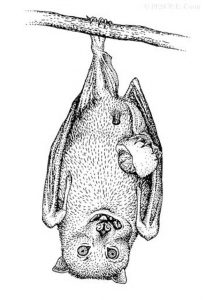
Luft, S. & G. Meier (1998): Zur Situation des Goldkronen-Flughundes (Acerodon jubatus) und des Kalong-Flughundes (Pteropus vampyrus) auf der Insel Boracay, Philippinen. Mitt. Zool. Ges. f. Art.- u. Pop.schutz 1, 10-13 (German)
Kock, D. & S. Luft (1998): Streblidae and Nycteribiidae (Insecta: Diptera) of Philippine Megachiroptera (Mammalia) mainly from Panay and Boracay Islands. National Museum Papers, 8, 1-16
Luft, S., & G. Meier (1999): Give Nature a Chance – Tourism on Boracay. J. on Environment, Energy and Minerals, II, 28-32. [A critical appraisal of survival and management prospects of the big bats on Boracay Isld., discussing the impact of the golf course among others.]
Luft, S. (2000): The use of olfactory cues in food location by Philippine fruit bats (Megachiroptera: Pteropodidae). Myotis 38, 109-112
Reiter, J. & E. Curio (2001): Home range, roost switching and foraging area in a Philippine fruit bat (Ptenochirus jagori). Ecotropica 7, 109-113
Curio, E., S. Luft & J. Reiter (2002): Vegetarische ‘Vampire’ – Flughunde als Gärtner im Regenwald. Rubin 12, 56-61. English version also available: Vegetarian ‘vampires’ – fruit bats gardening the rain forest. Ibidem
Fain, A. (2002): Notes on a small collection of mites (Acari) parasitic on bats in the Philippines. Acarologia 42: 67-74
Luft, S. , B. Tacud, H. Urbina & F. Geronimo (2002): Visual fruit preferences of Visayan Tarictic Hornbills, Penelopides panini panini (Bucerotiformes: Bucerotidae), and Musky Fruit Bats, Ptenochirus jagori (Megachiroptera: Pteropodidae), in cafeteria experiments. Silliman Journal 43: 42-58
Reiter, J. (2002): Differential ingestion of Ficus seeds by frugivorous bats: a first experimental test in Ptenochirus jagori (Pteropodidae). Acta Chiropterologica 4, 99-106 (2002) [DOI]
Luft, S. & E. Curio (2002): An improved necklace for marking fruit bats (Pteropodidae). Ecotropica 8, 249-251
Luft, S., E. Curio & B. Tacud (2003): The use of olfaction in the foraging behaviour of the golden-mantled flying Fox, Pteropus pumilus, and the greater musky fruit bat, Ptenochirus jagori (Megachiroptera: Pteropodidae). Naturwissenschaften 90, 84-87 [DOI]
Reiter, J., E. Curio, B. Tacud, H. Urbina & F. Geronimo (2004): Enhanced seed germination in Ficus and non-Ficus species after ingestion by Ptenochirus jagori (Pteropodidae). Myotis 41-42: 81-91.
Lorica, R. P., & E. Curio (in prep. 2005): Behavioral responses of the large flying foxes to human-induced disturbance. Unpublished Manuscript.
Reiter, J., E. Curio, B. Tacud, H. Urbina & F. Geronimo (2006): Tracking bat-dispersed seeds using fluorescent pigment. Biotropica 38 (1): 64-68.
van der Aa, P. J. H., R. P. Lorica & J. Komdeur (2006) The hormonal and behavioral response to the presence and activities of humans in three co-roosting flying fox species (Acerodon jubatus, Pteropus vampyrus and P. hypomelanus) in Boracay and Mambukal in the Philippines. Acta Zoologica Sinica 52: 827-837. [DOI]
Giupponi, A. P. L. & G. S. Miranda (2012): A new species of Sarax Simon, 1892 from the Philippines (Arachnida: Amblypygi: Charinidae). Anais da Academia Brasileira de Ciências (Annals Brazilian Acad. Sciences) 84: 165-173. [DOI]
Bleeding-heart pigeon
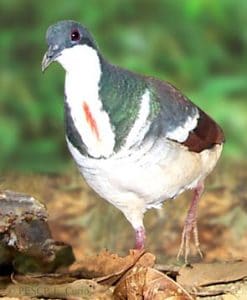
Klop, E., E. Curio & Y. de Soye (1998): A new population of bleeding-heart pigeon (Gallicolumba sp.) and its conservation relevance on Panay, Philippines. J. Ornithol. 139, 76-77 [DOI]
Curio, E., S. Luft & J. Reiter (2000): Die Dolchstichtaube von Panay, Philippinen – eine erste Bilddokumentation. Nachr. Vereinigg. f. Artenschutz, Vogelhaltung, Vogelzucht 47, 386-389 (German)
Curio, E. (2001): Taxonomic status of the Negros Bleeding-heart Gallicolumba keayi from Panay, Philippines, with notes on its behaviour. Forktail 17, 13-20
Slade, E. M., J. F. Villanueva, B. Tacud & E. Curio (2005): First nesting observations of the Negros Bleeding-heart Gallicolumba keayi from Panay, Philippines. Forktail 21: 161-163.
Kerhoas, D., Poole, J. & Abrahams, M. (2019). A systematic survey for the Critically Endangered Negros Bleeding-heart Gallicolumba keayi in the Northwest Panay Peninsula Natural Park, Philippines. BirdingAsia, 32, p50-56.
Mynott, H., Abrahams, M. and Kerhoas, D., 2020. Negros Bleeding-heart Gallicolumba keayi prefers dense understorey vegetation and dense canopy cover, and species distribution modelling shows little remaining suitable habitat. in review & BioRxiv, p.872044. [Link]
The Newly discovered Panay monitor or Mabitang
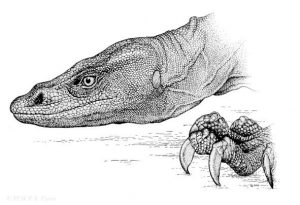
Gaulke, M. & E. Curio (2001): A new monitor lizard from Panay Island, Philippines (Reptilia, Sauria, Varanidae). Spixiana 24, 275-286
Gaulke, M., & A. Demegillo (2001): Gut versteckt in den Bäumen: Der Panay-Waran: Gut versteckt in den Bäumen entging er fast der Wissenschaft. – Mitteilungen der Zoologischen Gesellschaft Frankfurt, 2001 / 4: 4-6. (German)
Gaulke, M. (2002): Ein neuer Waran von den Philippinen – der Mabitang und das PESCP. Reptilia 35, 10-11. (German)
Struck, U., A. V. Altenbach, M. Gaulke, & F. Glaw (2002): Tracing the diet of the monitor lizard Varanus mabitang by stable isotope analysis (Delta 15N, Delta 13C). Naturwissenschaften 89, 470-473. [DOI]
Gaulke, M., E. Curio, A. Demegillo & N. Paulino (2002): Varanus mabitang, a rare monitor lizard from Panay Island and a new conservation target. Silliman Journal 43, 24-41.
Gaulke, M. (2005): Freilanduntersuchungen am Mabitang (Varanus mabitang), einer stark bedrohten Großwaran-Art von der Philippinen-Insel Panay. – Elaphe, 13 (1): 80-85. (German)
Gaulke, M., Altenbach, A.V., Demegillo, A. & U. Struck (2005): On the distribution and biology of Varanus mabitang. Silliman Journal, 46 (2): 89-117.
Ziegler, T., M. Gaulke & W. Böhme (2005) Genital morphology and systematics of Varanus mabitang Gaulke & Curio, 2001 (Squamata: Varanidae). Current Herpetology 24: 13-17. [DOI]
Gaulke, M., A. V. Altenbach, A. Demegillo & U. Struck (2007). On the diet of Varanus mabitang. Mertensiella 16: 228-239.
Gaulke, M. (2010) Overview on the present knowledge on Varanus mabitang Gaulke and Curio, 2001, including new morphological and meristic data. Biawak 4: 50-58.
Other Species
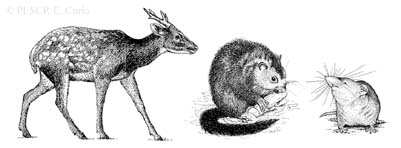
Curio, E., A.C. Diesmos, N.A.D Mallari & R.A.N Altamirano (1996): The Mindoro Scarlet-collared Flowerpecker Dicaeum retrocinctum – an Alleged Single Island Endemic. J. Ornithol. 137, 361-365 [DOI]
Schweigert, R. (1996): Neues zur Ökologie und Verbreitung der Panay-Borkenratte. Mitt. Zool. Ges. f. Art.- u. Pop.schutz 1, 14-15 (German)
Kock, D. & S. Luft (1998): Streblidae and Nycteribiidae (Insecta: Diptera) of Philippine Megachiroptera (Mammalia) mainly from Panay and Boracay Islands. National Museum Papers, 8, 1-16
Schweigert, R. (1998): Ecological and Distributional Notes on Crateromys heaneyi Gonzales and Kennedy, 1996 (Rodentia, Muridae) of Panay, Philippines. Z. Säugetierkde. 63, 121-123.
Curio, E., J. Hornbuckle, Y. de Soye, P. Aston & L. L. Lastimoza (2001): New birds records for the island of Panay, Philippines, including the first record of the Asian Stubtail Urosphaena squameiceps for the Philippines. Bull. B.O.C. 121, 183-197
Gaulke, M (2001).: Die Herpetofauna von Sibaliw (Panay), einem der letzten Tieflandregenwaldgebiete der West-Visayas, Philippinen. Part I: Herpetofauna 23, 5-14; part II: Herpetofauna 23, 23-34; part III: Herpetofauna 23, 5-18 (German)
Gaulke, M. (2001): Die Herpetofauna von Sibaliw (Panay), einem der letzten Tieflandregenwaldgebiete der West-Visayas, Philippinen – Teil I: Amphibien und Anmerkungen zu einer Schildkrötenart. – Herpetofauna 23, 5-14 (German)
Gaulke, M. (2001): Die Herpetofauna von Sibaliw (Panay), einem der letzten Tieflandregenwaldgebiete der West-Visayas, Philippinen – Teil II: Schlangen. – Herpetofauna 23, 23-34. (German)
Gaulke, M. (2001): Die Herpetofauna von Sibaliw (Panay), einem der letzten Tieflandregenwaldgebiete der West-Visayas, Philippinen – Teil III: Echsen und Diskussion. – Herpetofauna 23, 5-18. (German)
Gaulke, M., & J. Reiter (2001): Varanus salvator nuchalis, eine wenig bekannte Unterart des Bindenwarans. Draco, 7, 42-49. (German)
Gaulke, M. & J. Reiter (2001): Zur Biologie des Raunacken-Bindenwarans. Draco, 2, 42-49 (German)
Fain, A. (2002): Notes on a small collection of mites (Acari) parasitic on bats in the Philippines. Acarologia 42: 67-74
Gaulke, M. (2002): A new species of Lycodon from Panay Island, Philippines (Reptilia, Serpentes, Colubridae) – Spixiana, 25, 85-92.
Gaulke, M., & F. C. Cadiz (2002): Nachweis eines Massen-Schaumnestes des Weißbart-Ruderfrosches Polypedates leucomystax (Gravenhorst, 1829) in NW-Panay, Philippinen. Herpetofauna, 24, 13-17. (German)
Gaulke, M., A. Demegillo, J. Reiter & B. Tacud (2003) Additions to the herpetofauna of Panay Island, Philippines. Salamandra 39: 111-122.
Gaulke, M., Demegillo, A. & G. Vogel (2003/2004): Eine neue Unterart der Mangroven-Nachtbaumnatter von den Philippinen. A new subspecies of the Mangrove Cat Snake from the Philippines. Herpetofauna, 25 (143): 5-16
Gaulke, M. & G. Vogel (2005): Verbreitungsneunachweis und Längenrekord für Calamaria bitorques PETERS, 1872. Sauria, 27 (1): 15-19.
Gaulke, M., & Demegillo, A. D. (2006). A forked tail in a Philippine Sail-Fin Lizard (Hydrosaurus pustulatus [Eschscholtz, 1829]). Sauria 69: 4.
Gaulke, M., & G. Operiano (2006): Oxyrhabdium leporinum visayanum – Banded Philippine Burrowing Snake. Sauria 28: 51 – 52.
Gaulke, M., & G. Operiano (2006): Hoplobatrachus rugulosus – Chinese Bullfrog. Sauria 28: 51.
Gewers, G., E. Curio & S. H. Hembra (2006): First observations of an advertisement display flight of ‘Steere’s Honey-buzzard’ Pernis (celebensis) steerei on Panay, Philippines. Forktail 22: 163-165
Roesler, H., C. D. Siler, R. M. Brown, A. D. Demegillo & M. Gaulke (2006): Gekko ernstkelleri sp. n. – a new gekkonid lizard from Panay Island, Philippines. Salamandra 42 (4): 197-211.
Siegert, A., & E. Curio (2006). Pitfall traps misrepresent the terricoline fauna in a tropical forest: a novel evaluation. Silliman J. 47: 86-94.
Silva, A., V. Ketmaier, E. Curio & R. Tiedemann (2006): Co-evolution between avian malaria parasites and their host, the Philippine Bulbul (Hypsipetes philippinus). Abstract Graduate Student Conference of the German Zoological Society, New Markers and new Theories, Potsdam, 24-26 February, 2006
Villanueva, J. F., E. M. Slade & E. Curio (2006): The first observations of the breeding biology of the Elegant Tit Parus elegans in the Philippines. Ecol. Birds (Ökol. Vögel) 28: 31-46.
Gaulke, M., H. Roesler & R. M. Brown (2007). A new species of Luperosaurus (Squamata: Gekkonidae) from Panay Island, Philippines, with comments on the taxonomic status of Luperosaurus cumingii (Gray, 1845). Copeia, 2007/2: 413-425. [DOI]
Haupt, J. (2007). The Whipscorpion Minbosius manilanus (C. L. Koch 1843) on Panay Island (Philippines) (Arachnida, Uropygi, Thelyphonidae). Senckenbergiana biologica 87: 135-136
Annotation: specimens meanwhile found to be immature stages of the new species Telyphonoides panayensis described in 2009. (details)
Hutterer, R. (2007). Records of shrews from Panay and Palawan, Philippines, with the description of two new species of Crocidura (Mammalia: Soricidae). Lynx N.S., 38: 5-20 (two colour plates).
Siler, C.D., C. W. Linkem, A. C. Diesmos & A. C. Alcala (2007). A new species of Platymantis (Amphibia: Anura: Ranidae) from Panay Island, Philippines. Herpetologica 63: 351-364.
Gaulke, M., I. Frank & B. Tacud (2008) On the colour variability and breeding biology of some Philippine anurans. [Zur Farbvariabilität und Brutbiologie einiger philippinischer Anuren. German with Engl. Summary] SAURIA 30: 11-21.
Gaulke, M. & Curio, E. (2008): Die Jugendzeichnung zentral-philippinischer Königskobras (Ophiophagus hannah). – The colour pattern of juvenile King Cobras (Ophiophagus hannah) from the central Philippines. Sauria 30: 47–50.
Hembra, S.S., E. Curio & J. Jamangal (2008): Brutnachweis eines Philippinen-Fledermauspapageis. Papageien 21: 173-174. (German)
Gaulke, M., I. Frank & B. Tacud (2008) On the colour variability and breeding biology of some Philippine anurans. [Zur Farbvariabilität und Brutbiologie einiger philippinischer Anuren. German with Engl. Summary] SAURIA 30: 11-21.
Curio, E. & J. Tacud (2009): ‘Body morphing’ enables forest dwelling birds to master dense foliage with impunity: a novel avian flight performance. Ecology of Birds 31: 1-12.
Krehenwinkel, H., E. Curio, J. Tacud & J. Haupt (2009): On Telyphonoides panayensis gen. et sp. nov. (Arachnida: Uropygi: Telyphonidae), a new genus and a new species of whip scorpions from Panay Island (Philippines). Arthropoda Selecta 18: 139-143.
Javier, S. N. & C. O. Coleman (2010): Talitrus curioi (Crustacea, Amphipoda, Talitridae), a new species of landhopper from the rainforests of the Philippines. Zoosyst. Evol. 86: 41-48.
Annotation: specimens meanwhile found to belong to a distinct genus Curiotalitrus curiois described in 2012 by Lowry and Coleman [DOI]
Silva-Iturriza, A., V. Ketmaier & R. Tiedemann (2010): Mitochondrial DNA suggests multiple colonizations of central Philippine islands (Boracay, Negros) by the sedentary Philippine bulbul Hypsipetes philippinus guimarasensis (Aves). J. Zool. Syst. Evol. Res. 48: 269-278. [DOI]
Marek, C., N. Bissantz, E. Curio, A. Siegert, B. Tacud & D. Ziggel (2010): Spatial orientation of the Philippine bent-toed gecko (Cyrtodactylus philippinicus) in relation to its home range. Salamandra 46: 92-96.
Gaulke, M. (2011): The Herpetofauna of Panay Island, Philippines. Chimaira Buchhandelsgesellschaft mbH; Frankfurt, email: Frogbook@aol.com;
in the US available at Zoo Book Sales, Lanesboro, MN, USA, email: Zoobooks@acegroup.cc).
Gaulke, M. (2011): Wurzelkrebse. Ungewöhnliche Crustaceen-Parasiten. Caridina 4/2011: 21-19. (German)
Lourens, J. H. (2011): Six new Philippine species of the genus Cyana Walker, 1854 and a review of the geminipuncta-group, with emphasis on endemic development lines on various islands (Lepidoptera: Arctiidae, Lithosiinae). Nachr. entomol. Ver. Apollo, N. F. 32: 69-96.
Lowry, J., K. & C. O.. Coleman (2012): A new terrestrial talitrid genus from the Philippine Islands (Crustacea, Amphipoda, Talitrida, Talitridae) and the designation of two informal subgroups. Zootaxa 3400: 64-68.
Silva-Iturriza, A., V. Ketmaier & R. Tiedemann (2012) Prevalence of avian haemosporidian parasites and their host fidelity in the central Philippins islands. Parasitol. Intl. 61: 650-657.
Silva-Iturriza, A., V. Ketmaier & R. Tiedemann (2012) Profound population structure in the Philippine Bulbul Hypsipetes philippinus (Pycnonotidae, Aves) is not reflected in its Haemoproteus haemosproridian parasite. Infection, Genetics, Evolution 12: 127-136.
Gaulke, M. (2012a): Gruß von den Philippinen – Eine karstbewohnende Geosesarma in zwei Farbformen. Caridina 2/2012: 44-49. (German)
Gaulke, M. (2012b): Neue asiatische Landkrabben – Beobachtungen am Mount Madja-as, Philippinen. Caridina 4/2012: 26-29. (German)
Schwitzke, C., Fiala, B., Linsenmair, K. E. & Curio, E. (2015): Eucharitid ant-parasitoid affects facultative ant-plant Leea manillensis: top-down effects through three trophic levels. Arthropod-Plant Interactions 9: 497-505. Doi: 10.1007/s11829-015-9391-y.
Schwarz, Christian. (2021). Three new praying mantises from Panay Island, Philippines (Insecta: Mantodea). Integrative Systematics: Stuttgart Contributions to Natural History, 3(1) 35-56. DOI: 10.18476/insy.v03.a2. [Link]
Rehabilitation and Release
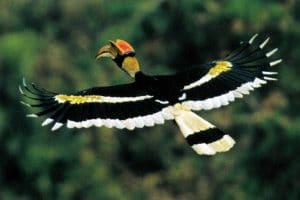
Curio, E. (1999): Bau von Auffangvolieren zur Aufzucht und zur Vorbereitung der Auswilderung kritisch bedrohter Hornvögel der Philippinen. Nachr. Vereinigg. f. Artenschutz, Vogelhaltung, Vogelzucht 46, 1006-1007 (German)
Curio, E. (2000): Abschlußbericht über die Errichtung von Auffangvolieren zur Rehabilitation bedrohter Vögel auf den Philippinen. Nachr. Vereinigg. f. Artenschutz, Vogelhaltung, Vogelzucht 47, 170-173
Curio, E. (submitted): The First ‚Soft Release’ of a Juvenile Tarictic Hornbill (Penelopides panini panini)
Hembra, S. S., B. Tacud, E. Geronimo, J. Villanueva, J. Jamangal, E. Sanchez, N. Bagac & E. Curio (2006): Saving Philippine Hornbills on Panay Island. Re-introduction News, No. 25: 45-46
EcoTourism

Luft, S. & G. Meier (1999): Give nature a chance – Tourism on Boracay. J. on Environment, Energy and Minerals II, 28-32